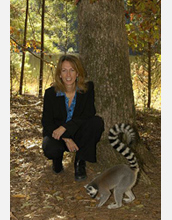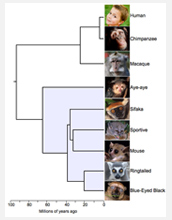All Images
Research News
Islands: Exquisite Labs of Evolution

Duke University Lemur Center Director Anne D. Yoder, with a Coquerel's Sifaka (Propithecus coquereli).
Credit: Duke University Lemur Center
Download the high-resolution JPG version of the image. (625 KB)
Use your mouse to right-click (Mac users may need to Ctrl-click) the link above and choose the option that will save the file or target to your computer.
Director Anne Yoder and Assistant Director Dean Gibson of the Duke University Lemur Center discuss the baby aye-aye, Ichabod, and the complex breeding behavior of aye-ayes. Aye-ayes are extremely rare in Madagascar because of habitat destruction and the animals are sometimes killed on sight because of local superstitution.
Credit: Duke University Lemur Center
Anne Yoder, the director of the Duke University Lemur Center, explains how some claims of new species of lemurs might be "irresponsible." A new species can be identified using morphology, behavior, ecology and statistics. The genetic distribution of genes in the population can be used to find out when the population stopped sharing genes.
Credit: Duke University Lemur Center

Duke University Lemur Center Director Anne D. Yoder with a ring-tailed lemur (Lemur catta).
Credit: Duke University Lemur Center
Download the high-resolution JPG version of the image. (172 KB)
Use your mouse to right-click (Mac users may need to Ctrl-click) the link above and choose the option that will save the file or target to your computer.

In 2007, a team of researchers from Duke University and the German Primate Centre compared genetic markers from several members of the primate family to draw a family tree that shows how lemurs and humans are related, and how the lemurs diverged after being split from the rest of the family 60 million years ago.
Credit: Duke University Lemur Center
Download the high-resolution JPG version of the image. (54 KB)
Use your mouse to right-click (Mac users may need to Ctrl-click) the link above and choose the option that will save the file or target to your computer.


